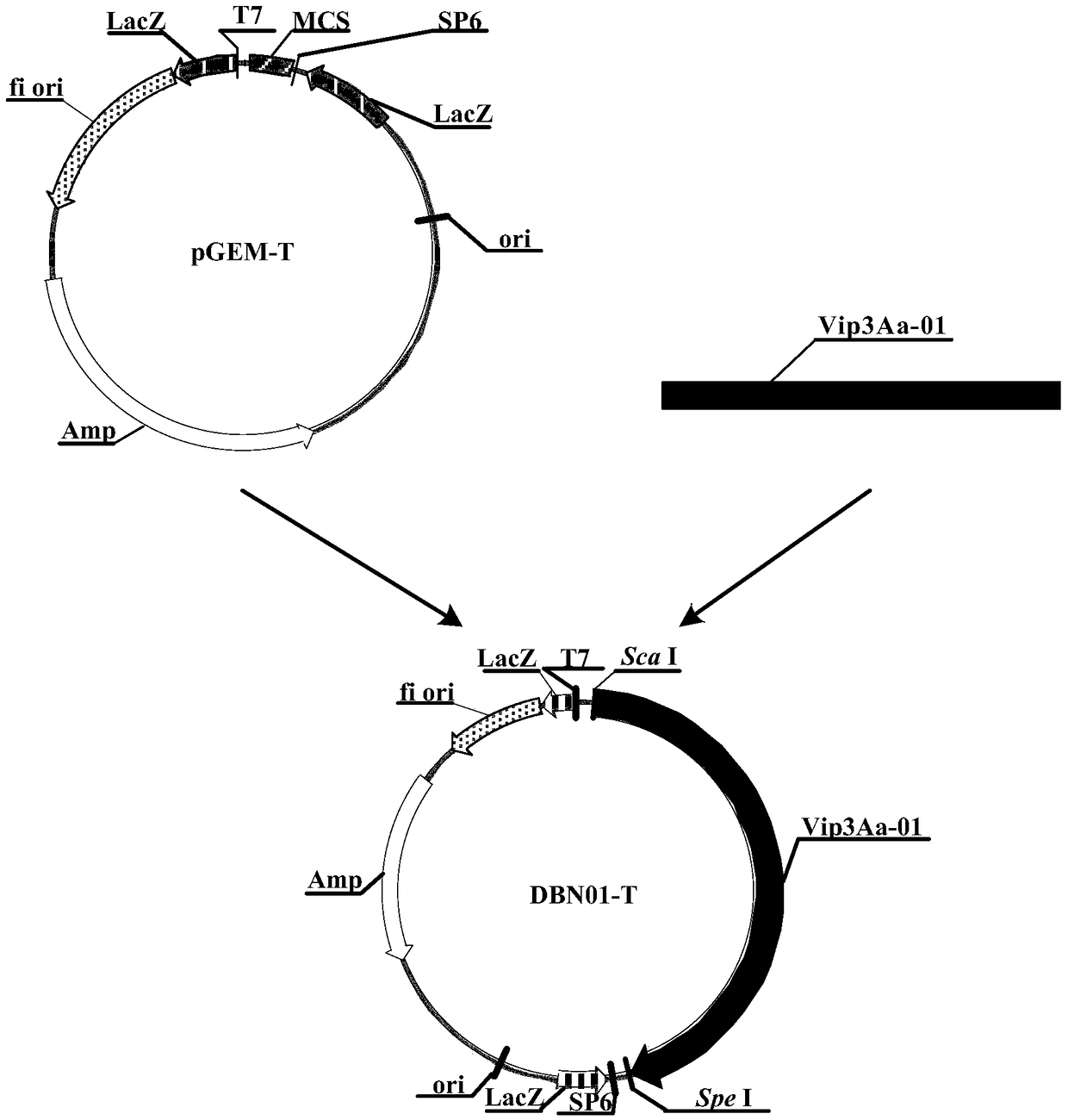Application of insecticidal protein
A protein and pest technology, applied in the field of insecticidal protein
- Summary
- Abstract
- Description
- Claims
- Application Information
AI Technical Summary
Problems solved by technology
Method used
Image
Examples
no. 1 example
[0085] The first embodiment, the acquisition and synthesis of genes
[0086] 1. Obtain the nucleotide sequence
[0087] The amino acid sequence (789 amino acids) of Vip3Aa-01 insecticidal protein, as shown in SEQ ID NO: 1 in the sequence listing; The Vip3Aa nucleotide sequence (2370 nucleotides) of coding corresponding to the amino acid sequence of described Vip3Aa insecticidal protein ), as shown in SEQ ID NO:2 in the sequence listing.
[0088] Amino acid sequence (789 amino acids) of Vip3Aa-02 insecticidal protein, as shown in SEQ ID NO:3 in the sequence listing; Vip3Aa-02 nucleotide sequence (2370 nucleotides), as shown in SEQ ID NO:4 in the sequence listing.
[0089] The amino acid sequence (615 amino acids) of Cry1Ab-01 insecticidal protein, as shown in SEQ ID NO:5 in the sequence listing; Cry1Ab-01 nucleotide sequence (1848 nucleotides), as shown in SEQ ID NO:6 in the sequence listing.
[0090] The amino acid sequence (634 amino acids) of Cry2Ab-01 insecticidal prote...
no. 2 example
[0093] The second embodiment, construction of recombinant expression vector and transformation of recombinant expression vector into Agrobacterium
[0094] 1. Construction of a recombinant cloning vector containing the Vip3Aa gene
[0095]The synthetic Vip3Aa-01 nucleotide sequence was connected to the cloning vector pGEM-T (Promega, Madison, USA, CAT: A3600), and the operation steps were carried out according to the instructions of the pGEM-T vector produced by Promega Company to obtain the recombinant cloning vector DBN01- T, whose construction process is as follows figure 1 Shown (among them, Amp represents the ampicillin resistance gene; f1 represents the replication origin of phage f1; LacZ is the actual codon of LacZ; SP6 is the promoter of SP6 RNA polymerase; T7 is the promoter of T7 RNA polymerase; Vip3Aa-01 is the promoter of Vip3Aa- 01 nucleotide sequence (SEQ ID NO: 2); MCS is a multiple cloning site).
[0096] Then, the recombinant cloning vector DBN01-T was tran...
no. 3 example
[0109] The third embodiment, the acquisition of transgenic plants
[0110] 1. Obtaining transgenic soybean plants
[0111] According to the routinely used Agrobacterium infection method, the cotyledon node tissue of the aseptically cultivated soybean variety Zhonghuang 13 was co-cultured with the Agrobacterium described in 3 in the second example, so that the recombinant gene constructed in 2 in the second example T-DNA of expression vectors DBN100002, DBN100741, DBN100003 and DBN100370 (including promoter sequence of Arabidopsis ubiquitin gene, Vip3Aa-01 nucleotide sequence, Vip3Aa-02 nucleotide sequence, Vip3Aa-02-Cry1Ab-01 core Nucleotide sequence, Vip3Aa-02-Cry2Ab-01 nucleotide sequence, PAT gene and tNos terminator sequence) were transferred into the soybean genome, and the soybean plants transferred to the Vip3Aa-01 nucleotide sequence, the transferred Vip3Aa The soybean plant of -02 nucleotide sequence, the soybean plant transferred to the Vip3Aa-02-Cry1Ab-01 nucleotid...
PUM
 Login to View More
Login to View More Abstract
Description
Claims
Application Information
 Login to View More
Login to View More - R&D Engineer
- R&D Manager
- IP Professional
- Industry Leading Data Capabilities
- Powerful AI technology
- Patent DNA Extraction
Browse by: Latest US Patents, China's latest patents, Technical Efficacy Thesaurus, Application Domain, Technology Topic, Popular Technical Reports.
© 2024 PatSnap. All rights reserved.Legal|Privacy policy|Modern Slavery Act Transparency Statement|Sitemap|About US| Contact US: help@patsnap.com










